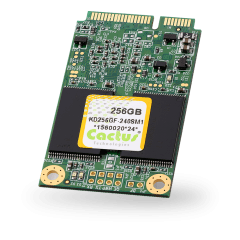Different mSATA (MO-300B) for Different Applications
 The miniSATA flash storage module, more popularly known as mSATA, makes an ideal solution for embedded OEM applications which require a physically mountable storage device which can be secured to the host platform via screws on one end and the card edge connector on the other.The miniSATA SSD have dimensions of 51 x 30mm as defined by the JEDEC MO-300B specification and adhere to the SATA-IO group’s electrical interface specification. The SATA interface offers high performance in a very small form factor.
The miniSATA flash storage module, more popularly known as mSATA, makes an ideal solution for embedded OEM applications which require a physically mountable storage device which can be secured to the host platform via screws on one end and the card edge connector on the other.The miniSATA SSD have dimensions of 51 x 30mm as defined by the JEDEC MO-300B specification and adhere to the SATA-IO group’s electrical interface specification. The SATA interface offers high performance in a very small form factor.Different mSATA Specifications:
The mSATA are made with several different types of components with widely differing reliability, longevity, cost and performance attributes. Since mSATA is such a convenient form factor, many designers do not consider which type of attributes the mSATA has and focus on the headline items such as price and/or performance.
While price and performance are important, getting the correct mSATA for your application should be the top priority. There are Industrial Grade mSATA based on SLC NAND flash, Industrial MLC mSATA based on MLC NAND flash and Consumer mSATA, based on the lowest cost flash which is generally TLC NAND. Cactus Technologies manufactures both an Industrial Grade and Industrial MLC mSATA.
For an in-depth review of SSD which also covers the different memory types, solid state drive interfaces and many other items - see downloadable SSD 101 EBook below.

Industrial Grade mSATA (MO-300B):
 As mentioned earlier, Industrial Grade mSATA are based on SLC NAND flash. They also have a controller which is focused on reliability versus only performance or cost. In this regard, there is typically not an external DRAM cache which is more susceptible to corruption if there is an unexpected power interruption. DRAM cache makes the SSD much faster, so a mSATA without this cache cannot achieve the same performance as a commercial or consumer mSATA.Two other features generally associated with Industrial Grade mSATA are a locked Bill-Of-Material (BOM) and long life cycles.Locked BOM signifies there are no changes in controller or NAND memory silicon and that the firmware does not change either. This is important since the invested time qualifying a mSATA for an application would be wasted if the BOM of the part and therefore characteristics is changed.A long life cycle of 5 - 7 years or more for the Industrial mSATA make qualification something that may only need to happen on the original design saving cost over the long run.
As mentioned earlier, Industrial Grade mSATA are based on SLC NAND flash. They also have a controller which is focused on reliability versus only performance or cost. In this regard, there is typically not an external DRAM cache which is more susceptible to corruption if there is an unexpected power interruption. DRAM cache makes the SSD much faster, so a mSATA without this cache cannot achieve the same performance as a commercial or consumer mSATA.Two other features generally associated with Industrial Grade mSATA are a locked Bill-Of-Material (BOM) and long life cycles.Locked BOM signifies there are no changes in controller or NAND memory silicon and that the firmware does not change either. This is important since the invested time qualifying a mSATA for an application would be wasted if the BOM of the part and therefore characteristics is changed.A long life cycle of 5 - 7 years or more for the Industrial mSATA make qualification something that may only need to happen on the original design saving cost over the long run.
Industrial MLC mSATA (MO-300B):
 Industrial MLC mSATA are based on MLC NAND flash. MLC has lower endurance cycles than the SLC NAND used in the Industrial Grade products. For many applications which are not write intensive, this may not be an issue.
Industrial MLC mSATA are based on MLC NAND flash. MLC has lower endurance cycles than the SLC NAND used in the Industrial Grade products. For many applications which are not write intensive, this may not be an issue.
Typically, a locked Bill-Of-Material (BOM) and long life cycles are NOT associated with MLC NAND based products. But, Cactus Industrial MLC products DO offer both of these items - a locked BOM and a long life cycle of 3+ years.
For embedded system designers who would like to discuss their applications and receive a recommendation which mSATA or other flash storage device would be the best solution, please contact us.






